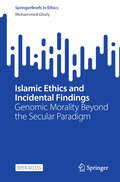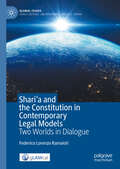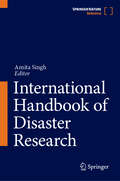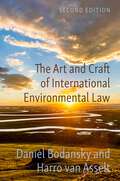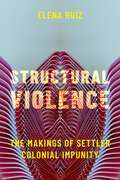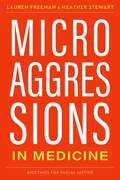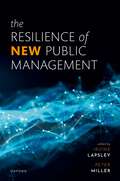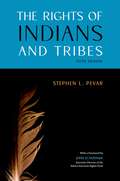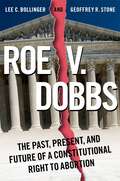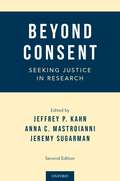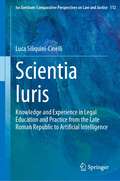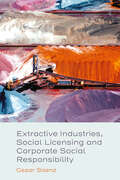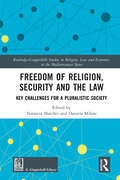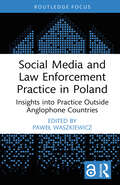- Table View
- List View
Islamic Ethics and Incidental Findings: Genomic Morality Beyond the Secular Paradigm (SpringerBriefs in Ethics)
by Mohammed GhalyThis open access book offers unique insights into the key ethical issues faced by practitioners and discussed by ethicists in the field of genomics and incidental findings, with a focus on the Islamic moral tradition. Embark on an enlightening exploration of key ethical challenges in genomics and incidental findings, uniquely tailored to the context of the Muslim Arab world. Following the regional scientific leap in genomic infrastructure, this study provides a timely response to the need for a solid evidence base that pairs scientific research with cutting-edge research in Islamic ethics. A variety of expert perspectives have been incorporated, which produce a holistic overview of the intricate, interwoven systems, including the status quo of genomic research in the Gulf region, related Islamic ethical deliberations, and, finally, the governing jurisdictions and regulations on the ground. This publication stands as a pioneer work for academics interested in various fields, including genomics, bioethics, and Islamic studies. It equally serves as an invaluable guide for practitioners and policy-makers, equipping them to make informed decisions that resonate with the socio-cultural and religio-ethical nuances of the Islamic tradition. Being multidisciplinary in nature, the study is written in such a way that makes it accessible for those without a specialized background in Islamic studies or genomics.
Shari'a and the Constitution in Contemporary Legal Models: Two Worlds in Dialogue (Global Issues)
by Federico Lorenzo RamaioliThis comparative law book aims at formulating a new analytical approach to constitutional comparisons, assuming as a starting point the different legal perspectives implied in the (Sunni) Islamic outlook on the juridical phenomena and the Western concept of law, with particular reference to constitutionalism. The volume adopts a wider and comprehensive viewpoint, comparing the different ways in which the Islamic sharīʿa and Western legal categories interact, regardless of substantive contents of specific provisions, thus avoiding conceptual biases that can sometime affect present literature on the matter. The book explores the various dynamics subtended to the interactions between sharīʿa and Western constitutionalism, providing a new classification to the different contemporary models. The philosophical and legal comparisons are analyzed in a dynamic way, based on a wide range of contemporary constitutional systems, virtually encompassing all the States in which Sunni Islam plays a major cultural role, and taking also into consideration non-State actors and non-recognized actors."Published in cooperation with gLAWcal - Global Law Initiatives for Sustainable Development, Hornchurch, Essex, United Kingdom".
The Falklands Saga: Volume 1
by Graham PascoeThe Falklands Saga presents abundant evidence from hundreds of pages of documents in archives and libraries in Buenos Aires, La Plata, Montevideo, London, Cambridge, Stanley, Paris, Munich and Washington DC, some never printed before, many printed here for the first time, in English and, where different, in their original languages, Spanish, French, German, Italian, Latin or Dutch. It provides the facts to correct the fallacies and distortions in accounts by earlier authors. It reveals persuasive evidence that the Falklands were discovered by a Portuguese expedition at the latest around 1518-19, and not by Vespucci or Magellan. It demonstrates conclusively that the Anglo-Spanish agreement of 1771 did not contain a reservation of Spanish rights, that Britain did not make a secret promise to abandon the islands, and that the Nootka Sound Convention of 1790 did not restrict Britain's rights in the Falklands, but greatly extended them at the expense of Spain. For the first time ever, the despairing letters from the Falklands written in German in 1824 to Louis Vernet by his brother Emilio are printed here in full, in both the original German and in English translation, revealing the total chaos of the abortive 1824 Argentine expedition to the islands. This book reveals how tiny the Argentine settlement in the islands was in 1826-33. In April 1829 there were only 52 people, and there was a constant turnover of population; many people stayed only a few months, and the population reached its maximum of 128 only for a few weeks in mid-1831 before declining to 37 people at the beginning of 1833. This work also refutes the falsehood that Britain expelled an Argentine population from the Falklands in 1833. That myth has been Argentina's principal propaganda weapon since the 1960s in its attempts to undermine Falkland Islanders' right to self-determination. In fact Britain encouraged the residents to stay, and only a handful left the islands. A crucial document printed here is the 1850 Convention of Peace between Argentina and Britain. At Argentina's insistence, this was a comprehensive peace treaty which restored "perfect friendship" between the two countries. Critical exchanges between the Argentine and British negotiators are printed here in detail, which show that Argentina dropped its claim to the Falklands and accepted that the islands are British. That, and the many later acts by Argentina described here, definitively ended any Argentine title to the islands. The islands' history is placed in its world context, with detailed accounts of the First Falklands Crisis of 1764-71, the Second Falklands Crisis of 1831-3, the Years of Confusion (1811-1850), and the Third Falklands Crisis of 1982 (the Falklands War), as well as a Falklands perspective on the First and Second World Wars, including the Battle of the Falklands (1914) and the Battle of the River Plate (1939), with extensive details and texts from German sources. The legal status of the Falklands is analysed by reference to legal works, to United Nations resolutions on decolonisation, and to rulings by the International Court of Justice, which together demonstrate conclusively that the islands are British territory in international law and that the Falkland Islanders, who have now (2024) lived in their country for over 180 years and for nine generations, are a unique people who are holders of territorial sovereignty with the full right of external self-determination.
The Falklands Saga: Volume 2
by Graham PascoeThe Falklands Saga presents abundant evidence from hundreds of pages of documents in archives and libraries in Buenos Aires, La Plata, Montevideo, London, Cambridge, Stanley, Paris, Munich and Washington DC, some never printed before, many printed here for the first time, in English and, where different, in their original languages, Spanish, French, German, Italian, Latin or Dutch. It provides the facts to correct the fallacies and distortions in accounts by earlier authors. It reveals persuasive evidence that the Falklands were discovered by a Portuguese expedition at the latest around 1518-19, and not by Vespucci or Magellan. It demonstrates conclusively that the Anglo-Spanish agreement of 1771 did not contain a reservation of Spanish rights, that Britain did not make a secret promise to abandon the islands, and that the Nootka Sound Convention of 1790 did not restrict Britain's rights in the Falklands, but greatly extended them at the expense of Spain. For the first time ever, the despairing letters from the Falklands written in German in 1824 to Louis Vernet by his brother Emilio are printed here in full, in both the original German and in English translation, revealing the total chaos of the abortive 1824 Argentine expedition to the islands. This book reveals how tiny the Argentine settlement in the islands was in 1826-33. In April 1829 there were only 52 people, and there was a constant turnover of population; many people stayed only a few months, and the population reached its maximum of 128 only for a few weeks in mid-1831 before declining to 37 people at the beginning of 1833. This work also refutes the falsehood that Britain expelled an Argentine population from the Falklands in 1833. That myth has been Argentina's principal propaganda weapon since the 1960s in its attempts to undermine Falkland Islanders' right to self-determination. In fact Britain encouraged the residents to stay, and only a handful left the islands. A crucial document printed here is the 1850 Convention of Peace between Argentina and Britain. At Argentina's insistence, this was a comprehensive peace treaty which restored "perfect friendship" between the two countries. Critical exchanges between the Argentine and British negotiators are printed here in detail, which show that Argentina dropped its claim to the Falklands and accepted that the islands are British. That, and the many later acts by Argentina described here, definitively ended any Argentine title to the islands. The islands' history is placed in its world context, with detailed accounts of the First Falklands Crisis of 1764-71, the Second Falklands Crisis of 1831-3, the Years of Confusion (1811-1850), and the Third Falklands Crisis of 1982 (the Falklands War), as well as a Falklands perspective on the First and Second World Wars, including the Battle of the Falklands (1914) and the Battle of the River Plate (1939), with extensive details and texts from German sources. The legal status of the Falklands is analysed by reference to legal works, to United Nations resolutions on decolonisation, and to rulings by the International Court of Justice, which together demonstrate conclusively that the islands are British territory in international law and that the Falkland Islanders, who have now (2024) lived in their country for over 180 years and for nine generations, are a unique people who are holders of territorial sovereignty with the full right of external self-determination.
The Art and Craft of International Environmental Law
by Daniel Bodansky Harro van AsseltIn countless ways we are affected by international environmental norms: some social, others legal; some quite general, others very specific. For example, the norms limiting the refrigerants used in air conditioners have been agreed upon in legal form internationally, and are mandated and enforced by national governments. The sustainable fishery and forestry standards used by Carrefour and Ikea were developed more informally by environmental groups and businesses, and are applied to producers through supply-chain contracts, without any government involvement. The reluctance to eat tuna fish or own elephant ivory reflects more general social norms, disseminated through education and culture. How and why do these norms arise? In what ways do they affect behavior? Do they change what states and individuals actually do and, if so, why? How effective are they in solving international environmental problems? In the second edition of The Art and Craft of International Environmental Law, Daniel Bodansky and Harro van Asselt explore these and other questions. Revisions cover the numerous developments spanning the 13 years since the first edition was published. New chapters address the growing role of environmental NGOs and the increasingly complex architecture of environmental law involving multiple institutions, levels of governance, and actors. Recent research has been incorporated on treaty design and policy implementation and effectiveness, and greater attention has been given to the role of the judiciary in standard-setting, implementation, and enforcement. A sophisticated yet highly readable introduction to how international environmental law works (and sometimes doesn't work), this book is essential reading for a wide audience.
Structural Violence: The Makings of Settler Colonial Impunity
by Elena Ru?zEnduring social inequalities in settler colonial societies are not an accident. They are produced and maintained by the self-repairing structural features and dynastic character of systemic racism and its intersecting oppressions. Using methods from diverse anticolonial liberation movements and systems theory, Structural Violence theorizes the existence of adaptive and self-replicating historical formations that underwrite cultures of violence in settler colonial societies. Corresponding epistemic forces tied to profit and wealth accumulation for beneficiary groups often go untracked. The account offered here argues that these epistemic forces play a central role in producing and maintaining massive health inequalities and the maldistribution of disease burdens?including those associated with sexual violence?for marginalized populations. It upends the widespread view that structural racism can be dismantled without addressing gendered violence. It also advocates for a theory of change rooted in reparative action and models of structural competency that respond to the built-in design of structural violence and the ecosystems of impunity that allow it to thrive.
Microaggressions in Medicine (Bioethics for Social Justice)
by Lauren Freeman Heather StewartIn a world that too often marginalizes people based on their race, gender, sexual orientation, body size, or disability, medicine can often be no different. Far from ?doing no harm,? it treats some patients unfairly, leading to detrimental effects. Guided by diverse patient testimonies and case studies, Microaggressions in Medicine focuses on the harms that such patients face. It amplifies their voices, stories, and experiences, which have too-often been excluded from mainstream bioethical, medical, and popular discussions. Microaggressions in medicine are not rare, but frequent in the healthcare experiences of marginalized patients. Recognizing this can help patients better understand and make sense of their experiences. As bioethicists Lauren Freeman and Heather Stewart argue, building such an awareness can also help current and future healthcare professionals recognize the serious and enduring consequences that microaggressions have on their patients. Freeman and Stewart offer practical strategies for healthcare professionals to reduce microaggressions in their practices. The harms of microaggressions are anything but micro. Healthcare professionals have a moral obligation to prevent them as much as possible. Health equity can be achieved, but only through first recognizing the harm caused by microaggressions in medical contexts. Shining a light on microaggressions in medicine and offering concrete ways for health professionals to avoid them in the future will make a positive difference in the lives of marginalized patients as they interact with medical institutions and practitioners. All patients deserve high quality, patient-centered care but healthcare professionals must change their practices in order to achieve such equity.
Structural Violence: The Makings of Settler Colonial Impunity
by Elena Ru?zEnduring social inequalities in settler colonial societies are not an accident. They are produced and maintained by the self-repairing structural features and dynastic character of systemic racism and its intersecting oppressions. Using methods from diverse anticolonial liberation movements and systems theory, Structural Violence theorizes the existence of adaptive and self-replicating historical formations that underwrite cultures of violence in settler colonial societies. Corresponding epistemic forces tied to profit and wealth accumulation for beneficiary groups often go untracked. The account offered here argues that these epistemic forces play a central role in producing and maintaining massive health inequalities and the maldistribution of disease burdens?including those associated with sexual violence?for marginalized populations. It upends the widespread view that structural racism can be dismantled without addressing gendered violence. It also advocates for a theory of change rooted in reparative action and models of structural competency that respond to the built-in design of structural violence and the ecosystems of impunity that allow it to thrive.
The Resilience of New Public Management
The Resilience of New Public Management examines the role and significance of New Public Management (NPM) in contemporary society, and explores its emergence and resilience. Eminent scholars have said that NPM only existed from 1980-2000, and that we now live in a post-NPM world. This book tells a very different story. Evidence is presented in this book of 40 years of continuous NPM in public services, including government agencies, universities, and health care. NPM has diffused across sectors and globally since the 1980s, and in the process mutated to become modernization. It also coexists with alternative models of managing public services, including models such as digital era governance and network governance which were considered replacements for NPM. The capacity of NPM to mutate has caught many of its critics by surprise. This capacity for NPM to reinvent itself includes the adoption of Lean Management, the Toyota Production System. Early NPM adopter countries engaged with the use of Lean Management techniques, but late NPM adopters did not. The most recent alternative to NPM is Trust-based management, which has made significant advances in Scandinavian countries. However, Trust-based management is closely linked to proto-NPM and NPM practices and it has itself mutated to present itself as a friendlier and more supportive version of NPM, which at the very least deserves close scrutiny. The above trends are indicative of the resilience of NPM, and its intuitive appeal for policymakers. Its advocates argue that NPM has the capacity to deliver policy outcomes, but this book shows that such claims and aspirations are not always matched by the evidence of NPM in action.
The Rights of Indians and Tribes
by Stephen L. PevarThe Rights of Indians and Tribes explains Federal Indian Law in a conversational manner, yet is highly authoritative, containing over 2000 footnotes with citations to relevant court decisions, statutes, and agency regulations. Since its initial publication in 1983 it has sold over 150,000 copies. It is user-friendly and particularly helpful for tribal advocates, students, government officials, lawyers, and members of the general public. The book uses a question-and-answer format and covers every important subject impacting Indians and tribes today and discusses which governments-tribal, state, and federal-have authority on Indian reservations. This fully-updated fifth edition provides a Foreword by John Echohawk, Director of the Native American Rights Fund, and covers the most significant legal issues facing Indians and Indian tribes. This includes the regulation of non-Indians on reservations, definitions of important legal terms, Indian treaties, the Indian Civil Rights Act, the Indian Gaming Regulatory Act, and the Indian Child Welfare Act.
The Rights of Indians and Tribes
by Stephen L. PevarThe Rights of Indians and Tribes explains Federal Indian Law in a conversational manner, yet is highly authoritative, containing over 2000 footnotes with citations to relevant court decisions, statutes, and agency regulations. Since its initial publication in 1983 it has sold over 150,000 copies. It is user-friendly and particularly helpful for tribal advocates, students, government officials, lawyers, and members of the general public. The book uses a question-and-answer format and covers every important subject impacting Indians and tribes today and discusses which governments-tribal, state, and federal-have authority on Indian reservations. This fully-updated fifth edition provides a Foreword by John Echohawk, Director of the Native American Rights Fund, and covers the most significant legal issues facing Indians and Indian tribes. This includes the regulation of non-Indians on reservations, definitions of important legal terms, Indian treaties, the Indian Civil Rights Act, the Indian Gaming Regulatory Act, and the Indian Child Welfare Act.
The Resilience of New Public Management
by Irvine LapsleyThe Resilience of New Public Management examines the role and significance of New Public Management (NPM) in contemporary society, and explores its emergence and resilience. Eminent scholars have said that NPM only existed from 1980-2000, and that we now live in a post-NPM world. This book tells a very different story. Evidence is presented in this book of 40 years of continuous NPM in public services, including government agencies, universities, and health care. NPM has diffused across sectors and globally since the 1980s, and in the process mutated to become modernization. It also coexists with alternative models of managing public services, including models such as digital era governance and network governance which were considered replacements for NPM. The capacity of NPM to mutate has caught many of its critics by surprise. This capacity for NPM to reinvent itself includes the adoption of Lean Management, the Toyota Production System. Early NPM adopter countries engaged with the use of Lean Management techniques, but late NPM adopters did not. The most recent alternative to NPM is Trust-based management, which has made significant advances in Scandinavian countries. However, Trust-based management is closely linked to proto-NPM and NPM practices and it has itself mutated to present itself as a friendlier and more supportive version of NPM, which at the very least deserves close scrutiny. The above trends are indicative of the resilience of NPM, and its intuitive appeal for policymakers. Its advocates argue that NPM has the capacity to deliver policy outcomes, but this book shows that such claims and aspirations are not always matched by the evidence of NPM in action.
Roe v. Dobbs: The Past, Present, and Future of a Constitutional Right to Abortion
With this volume, Roe v. Dobbs: The Past, Present and Future of a Constitutional Right of Abortion, we confront the remarkable beginning and end--once again, after a half-century-of the landmark Supreme Court decision in Roe v. Wade, shockingly overruled by the Court in Dobbs v. Jackson Women's Health Organization. The goal of this book is to bring together some of our nation's leading constitutional scholars, historians, philosophers, and medical experts to share their views on whether there should be a constitutional right to abortion and what the consequences of Dobbs might be. What makes this subject unique is how it intersects with our own lives, since both Bollinger and Stone were law clerks at the Supreme Court in the year that Roe was decided (1973)--Stone for Justice William Brennan and Bollinger for Chief Justice Warren Burger. During the Court's 1972 Term, when Roe was decided, the Court was in a state of flux. President Nixon had just appointed four Justices to the Court--Burger, Blackmun, Powell, and Rehnquist. The era of the Warren Court was clearly over. In those days, the Justices were non-partisan, often joined opinions across the political/ideological spectrum, and approached cases with an open mind. That in large part explains why the Court could reach the decision it did in Roe, with five of the six Republican-appointed Justices and two of the three Democratic-appointed Justices in the majority, and one Republican-appointed justice (Rehnquist) and one Democratic-appointed justice (White) in dissent. It was a different Court and a different era.
Roe v. Dobbs: The Past, Present, and Future of a Constitutional Right to Abortion
by Lee C. Bollinger and Geoffrey R. StoneWith this volume, Roe v. Dobbs: The Past, Present and Future of a Constitutional Right of Abortion, we confront the remarkable beginning and end--once again, after a half-century-of the landmark Supreme Court decision in Roe v. Wade, shockingly overruled by the Court in Dobbs v. Jackson Women's Health Organization. The goal of this book is to bring together some of our nation's leading constitutional scholars, historians, philosophers, and medical experts to share their views on whether there should be a constitutional right to abortion and what the consequences of Dobbs might be. What makes this subject unique is how it intersects with our own lives, since both Bollinger and Stone were law clerks at the Supreme Court in the year that Roe was decided (1973)--Stone for Justice William Brennan and Bollinger for Chief Justice Warren Burger. During the Court's 1972 Term, when Roe was decided, the Court was in a state of flux. President Nixon had just appointed four Justices to the Court--Burger, Blackmun, Powell, and Rehnquist. The era of the Warren Court was clearly over. In those days, the Justices were non-partisan, often joined opinions across the political/ideological spectrum, and approached cases with an open mind. That in large part explains why the Court could reach the decision it did in Roe, with five of the six Republican-appointed Justices and two of the three Democratic-appointed Justices in the majority, and one Republican-appointed justice (Rehnquist) and one Democratic-appointed justice (White) in dissent. It was a different Court and a different era.
Beyond Consent: Seeking Justice in Research
Justice is foundational to discussion, debate, and policy making surrounding biomedical research. Time-tested for more than 20 years, Beyond Consent examines the concept of justice and its application to research with human subjects, through multiple lenses of research populations of people who are sick (including those needing emergency medical care), cognitively impaired, children, captive and convenient (such as prisoners), women, racial minorities, communities, and living in international settings. This second edition includes new chapters on today?s leading-edge topics as well as updated chapters that consider what has changed, and what new matters have arisen. The result is a fresh treatment of the latest issues and concepts of justice in research examined by multidisciplinary scholars. This volume is a vital resource for students and scholars of bioethics, medicine, and public health policy; as well as for members of institutional review boards, research administrators, and policy makers.
Microaggressions in Medicine (Bioethics for Social Justice)
by Lauren Freeman Heather StewartIn a world that too often marginalizes people based on their race, gender, sexual orientation, body size, or disability, medicine can often be no different. Far from ?doing no harm,? it treats some patients unfairly, leading to detrimental effects. Guided by diverse patient testimonies and case studies, Microaggressions in Medicine focuses on the harms that such patients face. It amplifies their voices, stories, and experiences, which have too-often been excluded from mainstream bioethical, medical, and popular discussions. Microaggressions in medicine are not rare, but frequent in the healthcare experiences of marginalized patients. Recognizing this can help patients better understand and make sense of their experiences. As bioethicists Lauren Freeman and Heather Stewart argue, building such an awareness can also help current and future healthcare professionals recognize the serious and enduring consequences that microaggressions have on their patients. Freeman and Stewart offer practical strategies for healthcare professionals to reduce microaggressions in their practices. The harms of microaggressions are anything but micro. Healthcare professionals have a moral obligation to prevent them as much as possible. Health equity can be achieved, but only through first recognizing the harm caused by microaggressions in medical contexts. Shining a light on microaggressions in medicine and offering concrete ways for health professionals to avoid them in the future will make a positive difference in the lives of marginalized patients as they interact with medical institutions and practitioners. All patients deserve high quality, patient-centered care but healthcare professionals must change their practices in order to achieve such equity.
Beyond Consent: Seeking Justice in Research
by Jeffrey P. Kahn, Anna C. Mastroianni and Jeremy SugarmanJustice is foundational to discussion, debate, and policy making surrounding biomedical research. Time-tested for more than 20 years, Beyond Consent examines the concept of justice and its application to research with human subjects, through multiple lenses of research populations of people who are sick (including those needing emergency medical care), cognitively impaired, children, captive and convenient (such as prisoners), women, racial minorities, communities, and living in international settings. This second edition includes new chapters on today?s leading-edge topics as well as updated chapters that consider what has changed, and what new matters have arisen. The result is a fresh treatment of the latest issues and concepts of justice in research examined by multidisciplinary scholars. This volume is a vital resource for students and scholars of bioethics, medicine, and public health policy; as well as for members of institutional review boards, research administrators, and policy makers.
Scientia Iuris: Knowledge and Experience in Legal Education and Practice from the Late Roman Republic to Artificial Intelligence (Ius Gentium: Comparative Perspectives on Law and Justice #112)
by Luca Siliquini-CinelliLaw’s regulatory reach has grown significantly over the past few decades. Yet, at the same time, law schools and legal professions in Western and Western-oriented jurisdictions have undergone an acute crisis. How is this possible? In this insightful and wide-ranging book, Luca Siliquini-Cinelli argues that these trends are in fact complementary manifestations of a single phenomenon—namely, that law is and will always be more capable of regulating social interaction without the experiential contribution of legal experts. Siliquini-Cinelli contends that the separation of law’s regulatory function from legal experts is structurally linked to the former’s nature and operational dynamics as an intellectual artifact to be used for ordering purposes. As a product of the intellect, law is a matter of knowledge, not experience. In fact, Siliquini-Cinelli holds, law’s artifactuality voids experience, including that of legal experts, making it redundant. This explains how law can thrive as a regulatory phenomenon while the very places where future legal professionals are formed and those places where it is practised are in crisis. To show this, Siliquini-Cinelli embarks upon a historical, philosophical, and comparative analysis of law’s artifactuality, focusing on the teaching, study and practise of law as intellectual endeavours, from the advent of juristic activities in the Late Roman Republic to current legal pedagogies, practices, and reforms in Civil and Common law jurisdictions. In so doing, Siliquini-Cinelli employs the Latin phrase ‘scientia iuris’ to explain why and how legal education and practice pursue knowledge at the expense of experience, and the serious implications this has for lawyering activities. Moving beyond established narratives, Siliquini-Cinelli argues that ‘scientia iuris’ ought not be reduced to dogmatic analysis (scientia iuris as doctrina iuris). Rather, ‘scientia iuris’ denotes the knowledge of the law sought by all those who teach, study, and practise it, and which is actualised through a form of legal thinking and argumentation that moves along reason’s metaphysical, constructivist lines (scientia iuris as cognitio iuris). Thus, scientia iuris is not the prerogative of a few legal scholars; rather, it lies at the very core of Western legal education and practice, broadly understood. The relevance of Siliquini-Cinelli’s original and interdisciplinary analysis is profound and far-reaching: the crisis that legal education and practice are undergoing is not an isolated, or accidental, event; it is a consequence of the very ways in which law has been taught, studied, and practised since Rome. Endorsements ‘This richly researched book on the history of scientia iuris is a work on epistemology which argues that the legal model is highly problematic and will eventually be able to function without the intervention of jurists and lawyers. Such a thesis is based upon a very detailed knowledge both of philosophy and of the legal primary and secondary sources from Roman to modern times. The author is at home with Ancient Greek, Latin, French, German and Italian texts and this means that the research basis for the thesis not only is unusually profound – encompassing both the civil and the common law – but will make a major contribution to historical jurisprudence, to comparative legal history, to comparative law in general and to legal theory. This is legal scholarship of the highest order.’ Geoffrey Samuel, Emeritus Professor of Law, Kent Law School ‘In this exceptionally robust and expertly-researched new book, Luca Siliquini-Cinelli presents a provocative thesis. He proposes that the experience of legal experts is redundant when it comes to the success of law as a regulatory framework. Oscillating between historical, material, philosophical and literary frames, Siliquini-Cinelli introduces what he terms ‘law’s artifactuality’. Law’s artifac
Extractive Industries, Social Licensing and Corporate Social Responsibility
by Cesar SaenzCommunities are rightly concerned about the indiscriminate use of natural resources, environmental pollution, poverty, health, and education, among other social problems. Extractive and industrial companies therefore face the challenge of not only mitigating their social and environmental impacts, but also contributing proactively to the development of the communities within and beyond their area of influence. The challenge will always be to demonstrate that company operations generate well-being for shareholders and the communities. Extractive Industries, Social Licensing and Corporate Social Responsibility provides analytical tools to allow companies to improve their proposal to mitigate and compensate for their socio-environmental impacts and contribute to the development of the communities, as well as strategies used to improve the conditions of communities within and beyond their area of influence. These strategies can ensure the viability of projects, demonstrating that company operations generate a win-win relationship between companies and their communities. The interdisciplinary focus of the chapters presented here appeals to researchers in the areas of environment, ecology, economics and sociology, and practitioners in the extractive industries.
Extractive Industries, Social Licensing and Corporate Social Responsibility
by Cesar SaenzCommunities are rightly concerned about the indiscriminate use of natural resources, environmental pollution, poverty, health, and education, among other social problems. Extractive and industrial companies therefore face the challenge of not only mitigating their social and environmental impacts, but also contributing proactively to the development of the communities within and beyond their area of influence. The challenge will always be to demonstrate that company operations generate well-being for shareholders and the communities. Extractive Industries, Social Licensing and Corporate Social Responsibility provides analytical tools to allow companies to improve their proposal to mitigate and compensate for their socio-environmental impacts and contribute to the development of the communities, as well as strategies used to improve the conditions of communities within and beyond their area of influence. These strategies can ensure the viability of projects, demonstrating that company operations generate a win-win relationship between companies and their communities. The interdisciplinary focus of the chapters presented here appeals to researchers in the areas of environment, ecology, economics and sociology, and practitioners in the extractive industries.
Freedom of Religion, Security and the Law: Key Challenges for a Pluralistic Society (Routledge-Giappichelli Studies in Religion, Law and Economics in the Mediterranean Space)
by Natascia Marchei Daniela MilaniThis collection addresses many of the issues arising from the management of religious and cultural diversity in a multicultural society and refers to the complex relationship between the right to religious freedom and security. In recent decades, and particularly since September 2001, the right to religious freedom, which has hitherto been widely protected, has come up against a significant challenge in terms of security, or rather, in the subjectively and publicly perceived feelings of security. This book collects original theoretical, legal and comparative contributions addressing several implications for the right to freedom of religion or belief through the lens of security. It offers a new key to understanding how to manage the processes of integration of religious diversity in multifaith societies. Written by leading experts in the area, the work reveals the importance of avoiding simplistic conclusions and unfounded prejudices about religious freedom, and of limiting restrictive or repressive interventions to situations of genuine danger. The book will be an essential resource for researchers, academics and policy-makers working in the areas of Law and Religion, Human Rights Law and Security Studies.
Freedom of Religion, Security and the Law: Key Challenges for a Pluralistic Society (Routledge-Giappichelli Studies in Religion, Law and Economics in the Mediterranean Space)
This collection addresses many of the issues arising from the management of religious and cultural diversity in a multicultural society and refers to the complex relationship between the right to religious freedom and security. In recent decades, and particularly since September 2001, the right to religious freedom, which has hitherto been widely protected, has come up against a significant challenge in terms of security, or rather, in the subjectively and publicly perceived feelings of security. This book collects original theoretical, legal and comparative contributions addressing several implications for the right to freedom of religion or belief through the lens of security. It offers a new key to understanding how to manage the processes of integration of religious diversity in multifaith societies. Written by leading experts in the area, the work reveals the importance of avoiding simplistic conclusions and unfounded prejudices about religious freedom, and of limiting restrictive or repressive interventions to situations of genuine danger. The book will be an essential resource for researchers, academics and policy-makers working in the areas of Law and Religion, Human Rights Law and Security Studies.
Social Media and Law Enforcement Practice in Poland: Insights into Practice Outside Anglophone Countries (Routledge Studies in Crime, Culture and Media)
This book explores the role of social media in the daily practice of Polish criminal justice and how social media is, in turn, reshaping this practice. Based on empirical research, it confronts common beliefs about how police officers, prosecutors, and judges use social media in their work. Readers will find answers to the following questions: Which social media platforms are popular among law enforcement officers in Poland? How do the police use social media to investigate and prosecute crimes? What are the strategies for using social media to communicate with the community? What strategies are most successful?The findings in this book challenge some popular beliefs and theories about social media in criminal justice. As the first book to explore the use of social media in criminal justice outside of English-speaking countries, this collection of academic research will be of interest to academics focusing on criminology, criminal justice, and policing and will be useful to police leaders and officers, police social media administrators, prosecutors, and judges, who may be inspired by the research to implement new successful and more effective practices.The Open Access version of this book, available at www.taylorfrancis.com, has been made available under a Creative Commons Attribution-NonCommercial (CC-BY-NC) 4.0 International license. The costs of the Open Access publication were covered by the University of Warsaw under the Excellence Initiative Research University Action I.2.4 Supporting Open Access Publications.
Global Fintech Revolution: Practice, Policy, and Regulation
by Dr Lerong LuLerong Lu examines the biggest change in modern financial industry - the Fintech (financial technology) revolution - that denotes the close interaction between the financial services industry and latest information technologies such as big data, cloud computing, blockchain, and artificial intelligence. The three areas of banking institutions, online lending marketplaces, and money and payment systems are explored to assess how financial innovations affect the traditional financial industry, what kinds of regulatory challenges arise, and how global policymakers react to such challenges. With in-depth and international case studies on Fintech, including app-based banking services, mobile payments, P2P lending, and cryptocurrencies, the global Fintech hubs in six continents are assessed. The complex, dynamic, and multidimensional Fintech ecosystem is also investigated including its key players (such as regulatory strategy, regulatory sandbox, and RegTech) and Fintech corporations (including financial holding companies, Fintech unicorns, BigTech firms, and Metaverse platforms). Lu highlights the enormous benefits for financial institutions and their consumers and argues that Fintech contributes to a more equal, democratic, inclusive, and sustainable financial system. However, he also considers the risks and multiple legal, ethical, and regulatory challenges for policy-makers and financial authorities that Fintech has posed.
